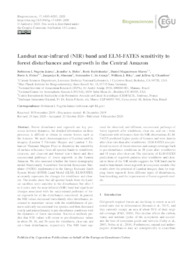Landsat near-infrared (NIR) band and ELM-FATES sensitivity to forest disturbances and regrowth in the Central Amazon.
Landsat near-infrared (NIR) band and ELM-FATES sensitivity to forest disturbances and regrowth in the Central Amazon.
Author(s): NEGRÓN-JUÁREZ, R. I.; HOLM, J. A.; FAYBISHENKO, B.; MAGNABOSCO-MARRA, D.; FISHER, R. A.; SHUMAN, J. K.; ARAUJO, A. C. de; RILEY, W. J.; CHAMBERS, J. Q.
Summary: Forest disturbance and regrowth are key processes in forest dynamics, but detailed information on these processes is difficult to obtain in remote forests such as the Amazon. We used chronosequences of Landsat satellite imagery (Landsat 5 Thematic Mapper and Landsat 7 Enhanced Thematic Mapper Plus) to determine the sensitivity of surface reflectance from all spectral bands to windthrow, clear-cut, and clear-cut and burned (cut+burn) and their successional pathways of forest regrowth in the Central Amazon. We also assessed whether the forest demography model Functionally Assembled Terrestrial Ecosystem Simulator (FATES) implemented in the Energy Exascale Earth System Model (E3SM) Land Model (ELM), ELM-FATES, accurately represents the changes for windthrow and clear-cut. The results show that all spectral bands from the Landsat satellites were sensitive to the disturbances but after 3 to 6 years only the near-infrared (NIR) band had significant changes associated with the successional pathways of forest regrowth for all the disturbances considered. In general, the NIR values decreased immediately after disturbance, increased to maximum values with the establishment of pioneers and early successional tree species, and then decreased slowly and almost linearly to pre-disturbance conditions with the dynamics of forest succession. Statistical methods predict that NIR values will return to pre-disturbance values in about 39, 36, and 56 years for windthrow, clear-cut, and cut+burn disturbances, respectively. The NIR band captured the observed, and different, successional pathways of forest regrowth after windthrow, clear-cut, and cut+burn. Consistent with inferences from the NIR observations, ELM-FATES predicted higher peaks of biomass and stem density after clear-cuts than after windthrows. ELM-FATES also predicted recovery of forest structure and canopy coverage back to pre-disturbance conditions in 38 years after windthrows and 41 years after clear-cut. The similarity of ELM-FATES predictions of regrowth patterns after windthrow and clear-cut to those of the NIR results suggests the NIR band can be used to benchmark forest regrowth in ecosystem models. Our results show the potential of Landsat imagery data for mapping forest regrowth from different types of disturbances, benchmarking, and the improvement of forest regrowth models.
Publication year: 2020
Types of publication: Journal article
Unit: Embrapa Eastern Amazon
Keywords: Amazonia, Regeneração florestal, Regrowth, Tropical forests
Observation
Some of Embrapa's publications are published as ePub files. To read them, use or download one of the following free software options to your computer or mobile device. Android: Google Play Books; IOS: iBooks; Windows and Linux: Calibre.
Access other publications
Access the Agricultural Research Database (BDPA) to consult Embrapa's full library collection and records.
Visit Embrapa Bookstore to purchase books and other publications sold by Embrapa.

